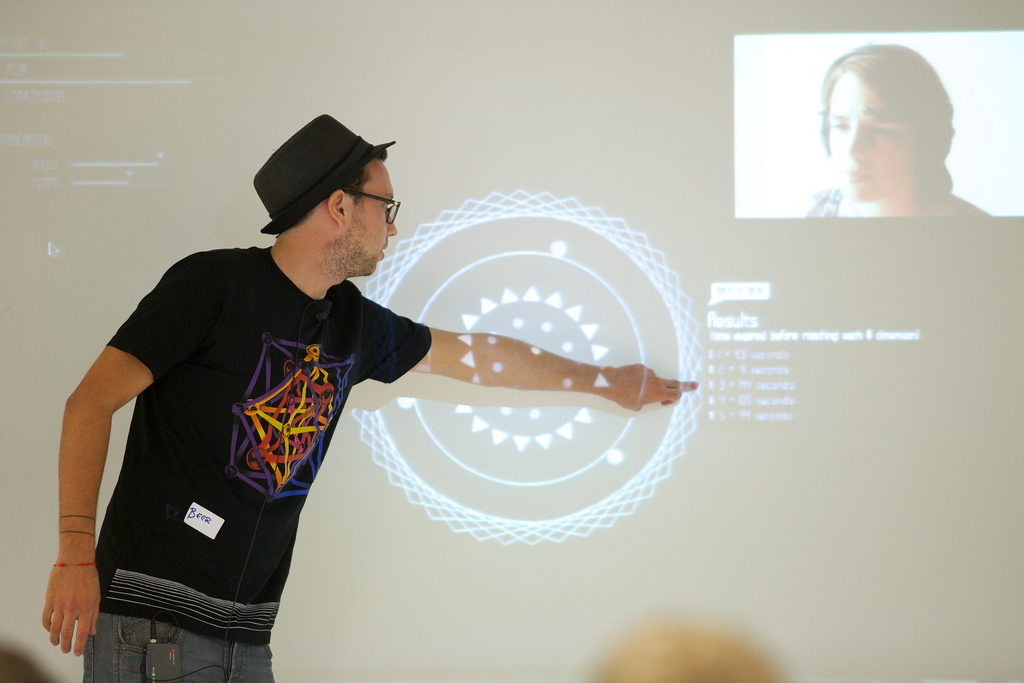08
Sep
2017
How does it sound to jam with your own heart?

Reading Time: 4 minutes
Dive into the interview with a Dutch biofeedback artist Beer van Geer, who uses heartbeat as a creative tool to make immersive multi-sensory environments
Beer van Geer (Universal Mediaman) is a media artist from Netherlands, who works in the fields of interactive biofeedback design. He develops systems that explore and explain the human world using various elements such as computer technology, visual/graphic design, and narratives. Been van Geer and his projects vary from websites to groundbreaking customized technology. Beer focuses on the interactive biofeedback design and the study of relations between physiology, geometry, sound, color, and harmony.
Biofeedback is a process that enables an individual to learn how to change physiological activity for the purposes of improving health and performance. Beer Van Geer together with the precise instruments measure physiological activity such as brainwaves, heart function, breathing, muscle activity, and skin temperature. These instruments rapidly and accurately “feedback” information to the user.
Through the interview, we will get to know Beer van Geer more and some of his works.
How did you become interested in biofeedback?
In 2009 the first neurofeedback (EEG) devices came on the market. It was the first time that EEG devices were affordable. Even though the quality was not that good, it allowed many users to play around with their own brainwaves. I bought the NeuroSky Mindset and started to make little projects with them. In that time I was very fascinated by the concept of a Mandala. A geometrical figure that can represent a whole universe filled with essential belief systems, for the person that makes it. I decided to make an interactive mandala system, connected to the EEG’s. That’s how it started
Why heart, and not the brain, for example?
I think the heart is much more interesting for different reasons. The signal of the heart is a fairly simple fluctuation. It consists of a single waveform, instead of the many waveforms you capture with brainwaves. Interacting with the heart’s single waveform is much easier than people think, the breathing is directly connected to the variation of the heart rate.
These fluctuations are very important to control emotions. Controlling the heart by breathing is an emotional controlling machine and it is easy to learn.
Ok so, Beer Van Geer, can you tell us something more about the project called “piece for heart and vibrations”? This project is very interesting because it is the first time that music performer uses her heart rate to create music on the scene.
After I made my first EEG apps, I started working with the company HeartLive. HeartLive is a heart rate device that some institutions in Netherlands use for therapies. It learns people how to use breathing exercises to calm down the heart rate. Instead of representing the data from the heart as boring numbers and graphs, I started to translate them into interesting shapes, colors, and sounds. Famous Dutch harpist, Gwyneth Wentink, contacted me and we decided to collaborate. I build a generative system that creates sounds and geometric visuals. Gwyneth could control this by breathing and monitoring her heart rate through HeartLive. The generative software creates a composition based on the variation, the more she breaths in a steady pace. The more the music and visuals come to life. The visuals show how music and biofeedback flow as energy in motion.
What role does the sound play in your works?
The sound is a really important aspect to understand. The laws of sound, the use of
harmonics and resonance are really the fundamentals of our universe. When you
understand the working of sound, you can also understand the working of for
example the human heart. In addition, the heart signal is not much different than sound, it consists of a bunch of waves of different frequencies, together creating a harmonic whole. These waves combined are similar as of how an orchestra is being shaped by all the different instruments. The systems that I make are intertwined with sound, geometry, and color. I like to design my systems with intertwined influences. For example, geometry represents the music sequence, which is, at the same time, translated to overtones of sound.
What is your favorite project?
That is pretty difficult to say. The biodome was a pretty successful project. This was an audio-visual installation that worked with biofeedback. It was fun because it was public and people could come inside our dome installation. I could see all the different heart rate and different
reactions of people.
You are currently working on sensory reality pod: an immersive sauna that integrates all senses: sound, smell, heat, visuals, heartbeats…
For Sensiks I’m working on the biofeedback integration of the project. The Sensiks Sensory Reality Pod will be a system, where designers can create experiences that stimulate the senses. My part will be to integrate biofeedback, so designers can work with emotional input in their designs.
Future plans?
In the future, I would like to release my own biofeedback device, that makes it easy for creatives, like for example musicians to use the rhythms of the heart and implement emotional feedback to their work. I’m planning to release the first version in 2018!
Love this article and would like to get to know more about how sound can help you with your body? Check this out.
Got a burning issue about sound and want to write about it? Well now you can, just drop us an email at [email protected] and you will be on your way!





